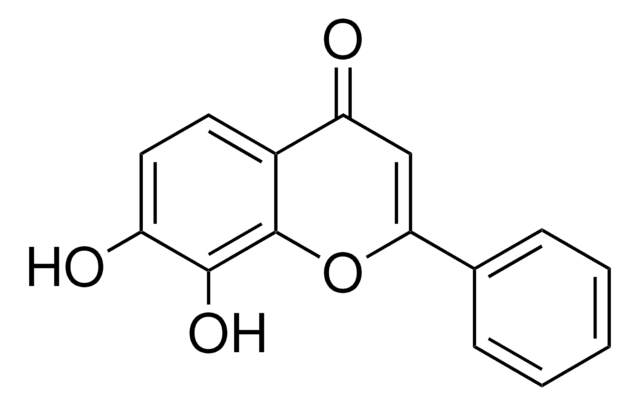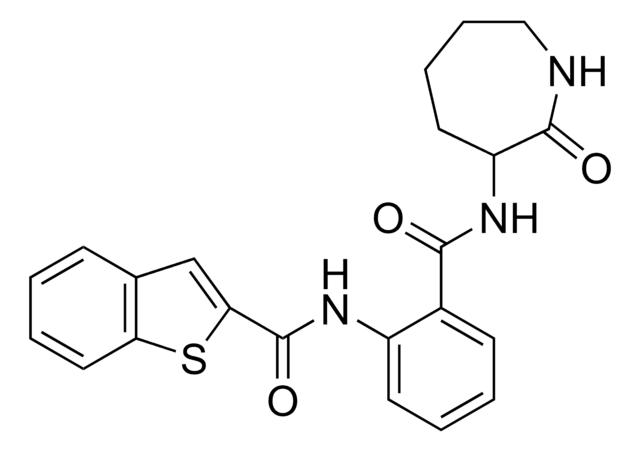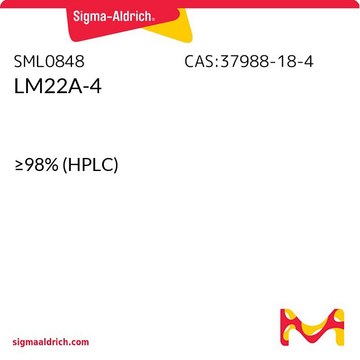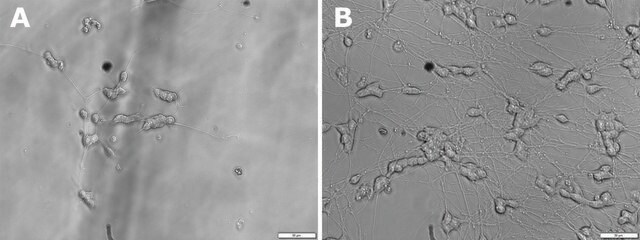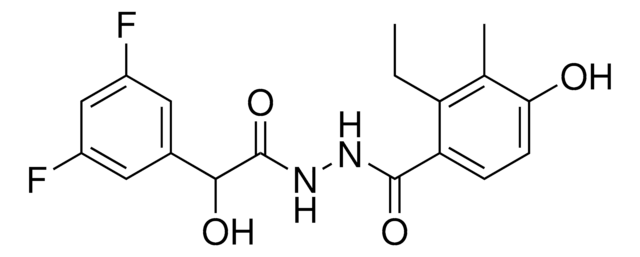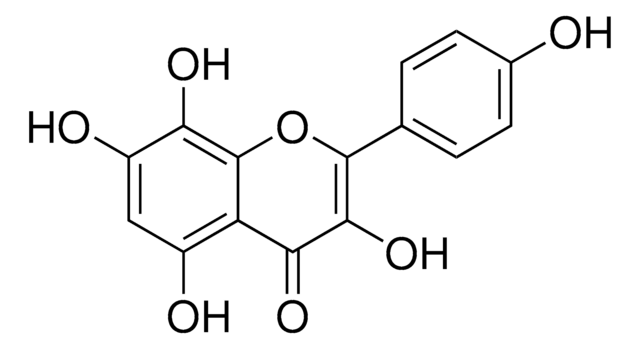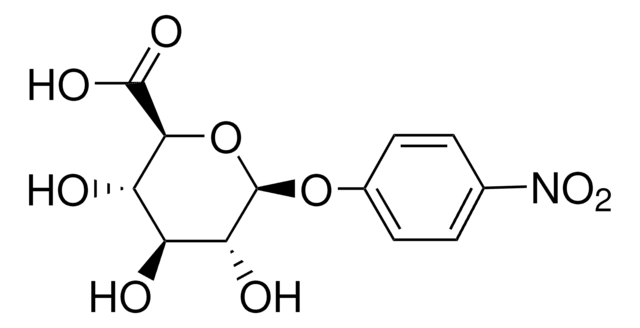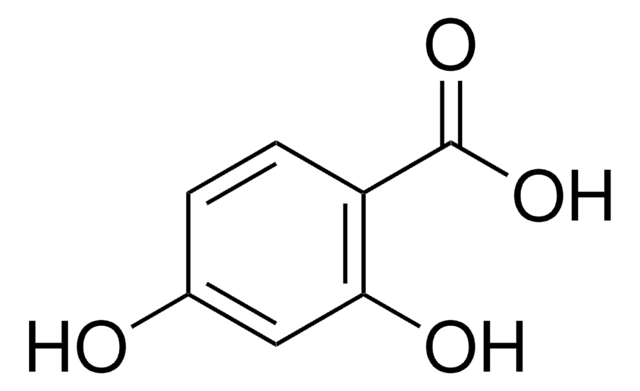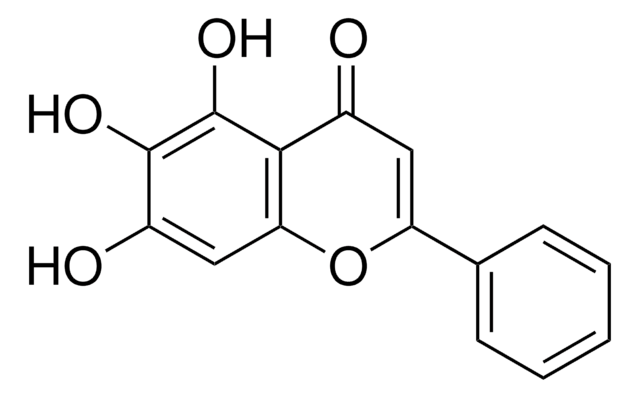Wszystkie zdjęcia(1)
Kluczowe dokumenty
D5446
7,8-Dihydroxyflavone hydrate
≥98% (HPLC)
Zaloguj sięWyświetlanie cen organizacyjnych i kontraktowych
About This Item
Wzór empiryczny (zapis Hilla):
C15H10O4 · xH2O
Numer CAS:
Masa cząsteczkowa:
254.24 (anhydrous basis)
Numer WE:
Numer MDL:
Kod UNSPSC:
12352200
Identyfikator substancji w PubChem:
NACRES:
NA.77
Polecane produkty
Próba
≥98% (HPLC)
Formularz
solid
warunki przechowywania
desiccated
rozpuszczalność
DMSO: 24 mg/mL
temp. przechowywania
room temp
ciąg SMILES
Oc1ccc2C(=O)C=C(Oc2c1O)c3ccccc3
InChI
1S/C15H10O4/c16-11-7-6-10-12(17)8-13(19-15(10)14(11)18)9-4-2-1-3-5-9/h1-8,16,18H
Klucz InChI
COCYGNDCWFKTMF-UHFFFAOYSA-N
Szukasz podobnych produktów? Odwiedź Przewodnik dotyczący porównywania produktów
Zastosowanie
7,8-Dihydroxyflavone hydrate has been used as tropomyosin-receptor-kinase B (TrkB) agonist in mice and to inhibit TrkB for monitoring evoked excitatory postsynaptic currents (eEPSCs).
Działania biochem./fizjol.
7,8-Dihydroxyflavone (7,8-DHF) may be used to help identify and differentiate the physiological effects and cell signaling pathways mediated by TrkB activation, such as those involving, memory, vasorelaxation and hypertension. 7,8-DHF elicits protection in scopolamine induced Alzheimer-like pathologic dysfunction.
7,8-Dihydroxyflavone is a selective TrkB receptor agonist
7,8-Dihydroxyflavone is a selective tyrosine kinase receptor B (TrkB) receptor agonist. It manifests all the therapeutic effects of brain-derived neurotrophic factor (BDNF)—such as protecting neurons from apoptosis, inhibiting kainic acid-induced toxicity, decreasing infarct volumes in stroke, and neuroprotecting in an animal model of Parkinson′s disease—without the poor pharmacokinetic profile of BDNF limiting its therapeutic potential.
Ta strona może zawierać tekst przetłumaczony maszynowo.
Kod klasy składowania
11 - Combustible Solids
Klasa zagrożenia wodnego (WGK)
WGK 3
Temperatura zapłonu (°F)
Not applicable
Temperatura zapłonu (°C)
Not applicable
Wybierz jedną z najnowszych wersji:
Masz już ten produkt?
Dokumenty związane z niedawno zakupionymi produktami zostały zamieszczone w Bibliotece dokumentów.
Klienci oglądali również te produkty
Oligodendrocytes regulate presynaptic properties and neurotransmission through BDNF signaling in the mouse brainstem
Jang M, et al.
eLife, 8, e42156-e42156 (2019)
7, 8-dihydroxyflavone ameliorates scopolamine-induced Alzheimer-like pathologic dysfunction
Chen C, et al.
Rejuvenation Research, 17(3), 249-254 (2014)
Autism-like behavior caused by deletion of vaccinia-related kinase 3 is improved by TrkB stimulation
Kang MS, et al.
The Journal of Experimental Medicine, 214(10), 2947-2966 (2017)
Vasorelaxing and antihypertensive effects of 7, 8-dihydroxyflavone
Huai R
American Journal of Hypertension, 27(5), 750-760 (2013)
Maria N Schultz et al.
Learning & memory (Cold Spring Harbor, N.Y.), 27(9), 346-354 (2020-08-21)
Angelman syndrome is a rare neurodevelopmental disorder caused by a mutation in the maternal allele of the gene Ube3a The primary symptoms of Angelman syndrome are severe cognitive deficits, impaired motor functions, and speech disabilities. Analogous phenotypes have been detected
Nasz zespół naukowców ma doświadczenie we wszystkich obszarach badań, w tym w naukach przyrodniczych, materiałoznawstwie, syntezie chemicznej, chromatografii, analityce i wielu innych dziedzinach.
Skontaktuj się z zespołem ds. pomocy technicznej